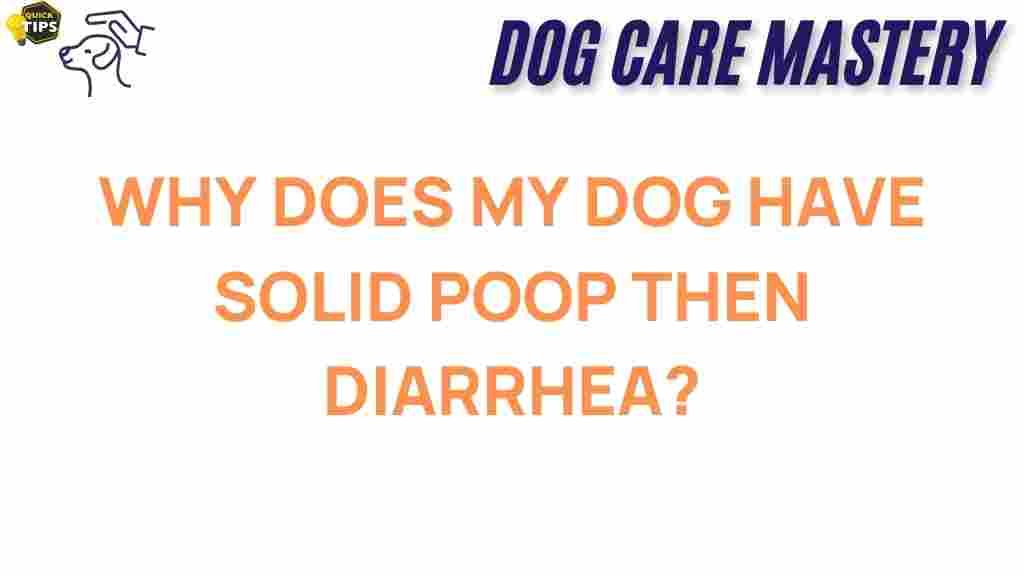Understanding Dog Health: Why Does My Dog Have Solid Poop Then Diarrhea?
As a loving dog owner, you want the best for your furry friend, including their health and well-being. One common issue that can cause concern is the sudden change in your dog’s stool consistency. You may notice your dog alternating between solid poop and diarrhea, which can be puzzling and alarming. In this article, we will unravel the mystery behind this phenomenon, explore potential causes, and provide you with actionable tips to ensure your dog’s health remains optimal.
What is Normal Dog Poop?
Before diving into the causes of inconsistent stool, it’s essential to understand what constitutes normal dog poop. Normal stool should be:
- Firm but not hard
- Moist but not overly wet
- Brown in color
- Easy to pick up
If your dog’s poop deviates from these characteristics, it may indicate an underlying issue that requires attention.
Common Causes of Solid Poop Followed by Diarrhea
There are several reasons why your dog’s poop may alternate between solid and loose. Understanding these causes is crucial for maintaining your dog’s health. Here are some of the most common factors:
1. Dietary Changes
Sudden changes in diet can disrupt your dog’s digestive system. If you’ve recently switched dog food or introduced new treats, your dog’s stomach may react negatively. Always transition slowly to new diets to avoid gastrointestinal upset.
2. Food Allergies or Intolerances
Some dogs may have allergies or intolerances to specific ingredients in their food. Symptoms can include alternating stool types, scratching, or gastrointestinal distress. Common allergens include:
- Beef
- Chicken
- Dairy
- Grains
If you suspect food allergies, consult your veterinarian for an appropriate elimination diet.
3. Stress and Anxiety
Dogs, like humans, can experience stress and anxiety, leading to gastrointestinal issues. Changes in environment, loud noises, or new family members can trigger these feelings. Monitor your dog’s behavior and try to minimize stressors.
4. Gastrointestinal Infections
Infections caused by bacteria, viruses, or parasites can lead to diarrhea. Common culprits include:
- Parvovirus
- Salmonella
- Giardia
If your dog shows signs of infection, such as lethargy, vomiting, or fever, seek veterinary help immediately.
5. Ingestion of Unusual Items
Dogs are notorious for eating things they shouldn’t, from toys to garbage. This behavior can lead to gastrointestinal blockages or irritation, causing changes in stool consistency. Always supervise your dog and discourage scavenging.
6. Medical Conditions
Underlying health issues, such as pancreatitis, inflammatory bowel disease, or liver disease, can also lead to alternating stool types. If the problem persists, it’s essential to consult a veterinarian for a thorough examination.
Step-by-Step Process to Address Your Dog’s Stool Changes
When faced with the issue of alternating solid poop and diarrhea, a systematic approach can help you determine the next steps:
Step 1: Monitor Your Dog
Keep a close eye on your dog’s behavior, eating habits, and stool consistency. Note any changes in energy levels, appetite, or signs of distress. This information will be valuable for your veterinarian.
Step 2: Evaluate Dietary Changes
If you’ve recently changed your dog’s diet, consider reverting to the previous food to see if the stool consistency improves. If introducing new treats, eliminate them to identify potential allergens.
Step 3: Check for Stressors
Assess your dog’s environment for any stressors or changes that may be affecting them. Providing a calm and stable environment can help alleviate anxiety-related gastrointestinal issues.
Step 4: Consult Your Veterinarian
If the problem persists for more than 24 hours or is accompanied by severe symptoms (vomiting, lethargy), it’s time to consult your veterinarian. They may recommend tests to identify underlying health issues.
Step 5: Follow Veterinary Advice
Based on the diagnosis, your veterinarian may suggest dietary changes, medications, or other treatments to address the issue. Always follow their recommendations for the best outcomes regarding your dog’s health.
Troubleshooting Tips for Dog Owners
Here are some additional troubleshooting tips to keep your dog’s health in check:
- Keep a Stool Diary: Document your dog’s stool consistency, frequency, and any accompanying symptoms. This can help identify patterns and assist your veterinarian in diagnosis.
- Hydration is Key: Ensure your dog stays hydrated, especially if they are experiencing diarrhea. Dehydration can lead to more severe health issues.
- Gradual Dietary Changes: When switching foods, do so gradually over a week to reduce gastrointestinal upset.
- Regular Vet Check-ups: Schedule routine veterinary visits to monitor your dog’s overall health and address any emerging issues.
When to Seek Immediate Veterinary Care
While occasional changes in stool may not be a cause for alarm, certain signs indicate the need for immediate veterinary attention:
- Persistent diarrhea for more than 24 hours
- Severe vomiting
- Signs of dehydration (dry gums, lethargy, excessive thirst)
- Blood in the stool or vomit
- Abdominal pain or bloating
If you notice any of these symptoms, contact your veterinarian without delay. Early intervention can be crucial in safeguarding your dog’s health.
Conclusion
Understanding why your dog experiences solid poop followed by diarrhea is essential for maintaining their health. By monitoring their behavior, evaluating dietary changes, and seeking veterinary advice when needed, you can help resolve these issues and ensure your furry friend remains happy and healthy.
Remember, your dog’s health is paramount. If you’re ever in doubt, don’t hesitate to reach out to a veterinary professional for guidance. For more information on dog health, you can visit this resource to learn about common health issues and preventive care.
With proper care and attention, you can keep your dog thriving and enjoying life to the fullest.
This article is in the category Health and created by dogcaremastery Team
